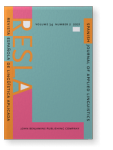Vol. 34:2 (2021) ► pp.555–584
Vol. 34:2 (2021) ► pp.555–584
Interclausal relations with Old English verbs of inaction
Synchronic variation and diachronic change
The aim of this article is to analyse the syntactic and semantic interclausal relations that hold with Old English verbs of inaction. These verbs are studied from the perspective of juncture-nexus relations and the semantic relations Phase, Psych-action and Causative. The results are compared on the grounds of the Interclausal Relations Hierarchy. The comparison of semantic content and syntactic expression evidences discrepancies between too weak juncture-nexus types, such as clausal subordination, and very close semantic relations, like Phase. Two main conclusions are drawn. Firstly, the Interclausal Relations Hierarchy allows us to describe the variation in the complementation of inaction verbs in Old English; and to make predictions on the diachronic axis, given that the loss of finite clause complementation and the change to infinitival complementation presented by Present-Day English verbs of inaction are fully predicted by the IRH. Secondly, semantic relations and nexus types remain stable throughout the change, whereas juncture levels change.
Article outline
- 1.Introduction
- 2.Theoretical background
- 3.Variation in Old English nominal complementation
- 4.The status of tō
- 5.Research methodology
- 6.The semantic relation Phase
- 7.The semantic relation Psych-action
- 8.The semantic relation Causative
- 9.Results
- 10.Conclusion
- Notes
-
References
